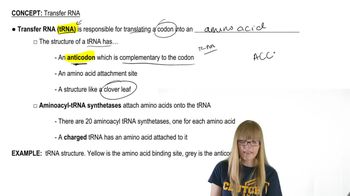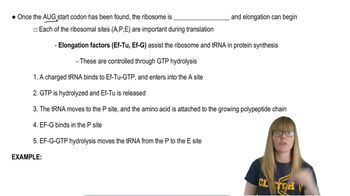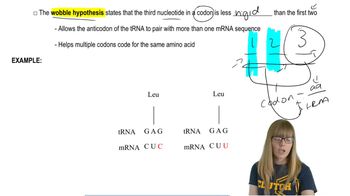Table of contents
- 1. Introduction to Genetics51m
- 2. Mendel's Laws of Inheritance3h 37m
- 3. Extensions to Mendelian Inheritance2h 41m
- 4. Genetic Mapping and Linkage2h 28m
- 5. Genetics of Bacteria and Viruses1h 21m
- 6. Chromosomal Variation1h 48m
- 7. DNA and Chromosome Structure56m
- 8. DNA Replication1h 10m
- 9. Mitosis and Meiosis1h 34m
- 10. Transcription1h 0m
- 11. Translation58m
- 12. Gene Regulation in Prokaryotes1h 19m
- 13. Gene Regulation in Eukaryotes44m
- 14. Genetic Control of Development44m
- 15. Genomes and Genomics1h 50m
- 16. Transposable Elements47m
- 17. Mutation, Repair, and Recombination1h 6m
- 18. Molecular Genetic Tools19m
- 19. Cancer Genetics29m
- 20. Quantitative Genetics1h 26m
- 21. Population Genetics50m
- 22. Evolutionary Genetics29m
11. Translation
Translation
Problem 15d
Textbook Question
The three major forms of RNA (mRNA, tRNA, and rRNA) interact during translation.
Describe the role each form of RNA performs during translation.
 Verified step by step guidance
Verified step by step guidance1
mRNA (messenger RNA) serves as the template for protein synthesis. It carries the genetic information from DNA in the nucleus to the ribosome, where translation occurs.
tRNA (transfer RNA) is responsible for bringing the correct amino acids to the ribosome in accordance with the sequence of codons on the mRNA. Each tRNA molecule has an anticodon that pairs with a specific mRNA codon.
rRNA (ribosomal RNA) is a key structural and functional component of the ribosome. It helps to catalyze the formation of peptide bonds between amino acids, facilitating the assembly of the polypeptide chain.
During translation, the ribosome moves along the mRNA, reading its sequence three nucleotides at a time (codon), and coordinating the interaction between mRNA and tRNA.
The process continues until a stop codon on the mRNA is reached, signaling the end of protein synthesis and the release of the newly formed polypeptide chain.
Recommended similar problem, with video answer:
 Verified Solution
Verified SolutionThis video solution was recommended by our tutors as helpful for the problem above
Video duration:
2mPlay a video:
Was this helpful?
Key Concepts
Here are the essential concepts you must grasp in order to answer the question correctly.
mRNA (messenger RNA)
mRNA serves as the template for protein synthesis during translation. It is synthesized from DNA and carries the genetic information from the nucleus to the ribosome, where it dictates the sequence of amino acids in a protein. Each mRNA molecule is composed of codons, which are three-nucleotide sequences that correspond to specific amino acids.
Recommended video:
tRNA (transfer RNA)
tRNA is responsible for bringing the appropriate amino acids to the ribosome during translation. Each tRNA molecule has an anticodon that is complementary to a specific mRNA codon, ensuring that the correct amino acid is added to the growing polypeptide chain. This process is crucial for accurately translating the genetic code into functional proteins.
Recommended video:
rRNA (ribosomal RNA)
rRNA is a key structural and functional component of ribosomes, the cellular machinery where translation occurs. It helps to catalyze the formation of peptide bonds between amino acids and ensures the proper alignment of mRNA and tRNA during protein synthesis. rRNA plays a critical role in maintaining the integrity and functionality of the ribosome.
Recommended video:

 7:58m
7:58mWatch next
Master Translation initiation with a bite sized video explanation from Kylia Goodner
Start learning






